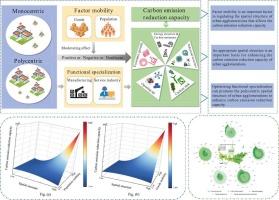The divergent effects of spatial structure of urban agglomerations on carbon emission reduction capacity
IF 6.9
2区 工程技术
Q1 ENVIRONMENTAL SCIENCES
引用次数: 0
Abstract
The adjustment of the spatial structure of urban agglomerations is an effective tool for improving carbon emission reduction. Given the complexity of sustainable environment and carbon emission reduction, urban low-carbon transformation faces challenges such as population agglomeration, factor mobility, and urban expansion. This study constructs a carbon emission reduction capacity indicator system and adopts Zipf's law to measure the centrality index of the spatial structure of urban agglomerations. The influence of spatial structure on carbon emission reduction capacity is verified using five Chinese national urban agglomerations in the Yellow River Basin. The results show that urban agglomerations are dominated by a polycentric spatial structure, with strong carbon emission reduction capacity in the middle and lower reaches and weak capacity in the upper reaches. Carbon emission reduction capacity presents an inverted U-shaped relationship with spatial structure, and functional specialization presents nonlinear mediating effects. Carbon emission reduction effects can be maximized through rational functional specialization of the spatial structure. The moderation of the increase in factor mobility shows a weakening effect. Thus, a moderately polycentric spatial structure of urban agglomerations should be optimized to promote production factor mobility through sustainable governance. Reasonable urban functional positioning and the coordinated management of carbon emission reduction among cities should be developed.

城市群空间结构对碳减排能力的发散效应
城市群空间结构调整是促进碳减排的有效手段。考虑到可持续环境和碳减排的复杂性,城市低碳转型面临着人口集聚、要素流动和城市扩张等挑战。本研究构建了碳减排能力指标体系,采用Zipf定律测度城市群空间结构的中心性指数。以黄河流域5个国家级城市群为例,验证了空间结构对碳减排能力的影响。结果表明:城市群以多中心空间结构为主,中下游碳减排能力强,上游碳减排能力弱;碳减排能力与空间结构呈倒u型关系,功能专业化呈现非线性中介效应。通过合理的空间结构功能分工,实现碳减排效果的最大化。要素流动性增加的缓和作用呈现出减弱的趋势。因此,应优化城市群适度多中心的空间结构,通过可持续治理促进生产要素的流动。开展合理的城市功能定位和城市间碳减排协调管理。
本文章由计算机程序翻译,如有差异,请以英文原文为准。
求助全文
约1分钟内获得全文
求助全文
来源期刊

Urban Climate
Social Sciences-Urban Studies
CiteScore
9.70
自引率
9.40%
发文量
286
期刊介绍:
Urban Climate serves the scientific and decision making communities with the publication of research on theory, science and applications relevant to understanding urban climatic conditions and change in relation to their geography and to demographic, socioeconomic, institutional, technological and environmental dynamics and global change. Targeted towards both disciplinary and interdisciplinary audiences, this journal publishes original research papers, comprehensive review articles, book reviews, and short communications on topics including, but not limited to, the following:
Urban meteorology and climate[...]
Urban environmental pollution[...]
Adaptation to global change[...]
Urban economic and social issues[...]
Research Approaches[...]
 求助内容:
求助内容: 应助结果提醒方式:
应助结果提醒方式:


